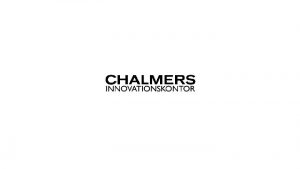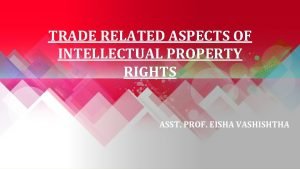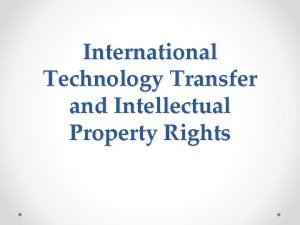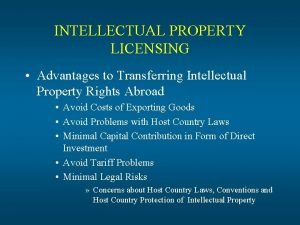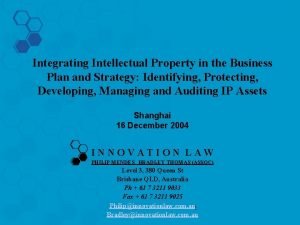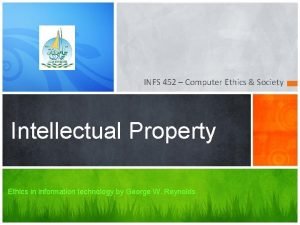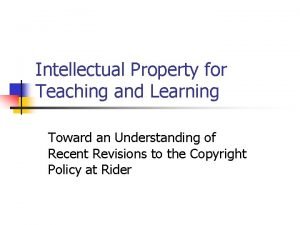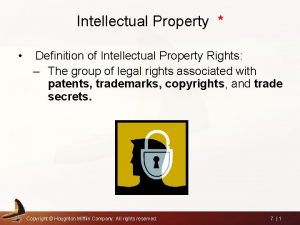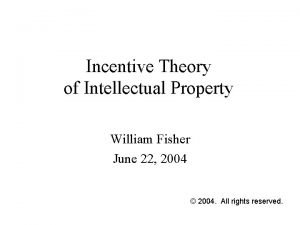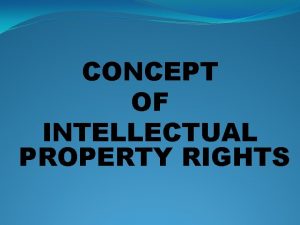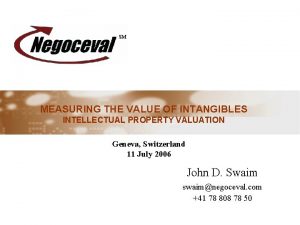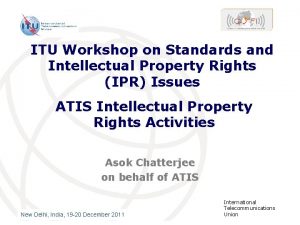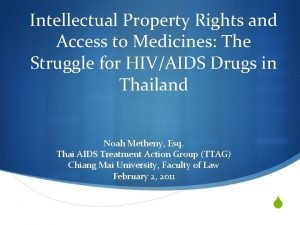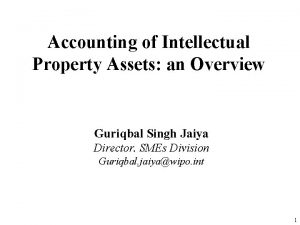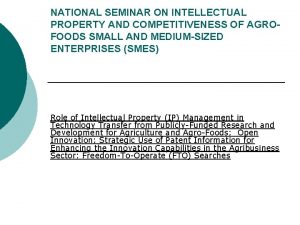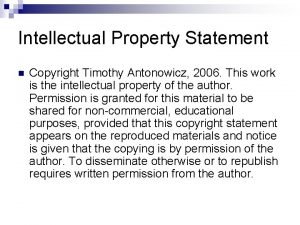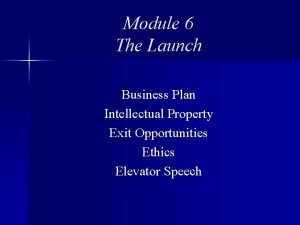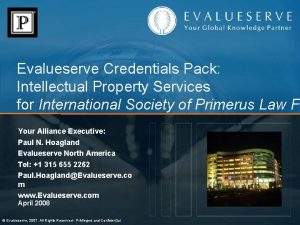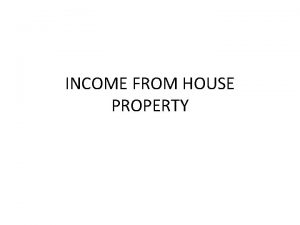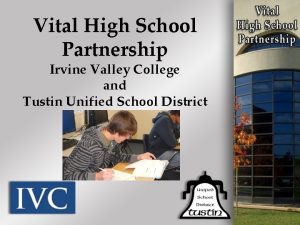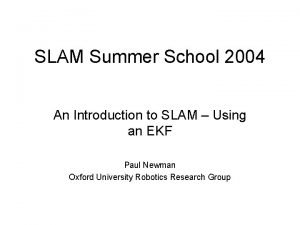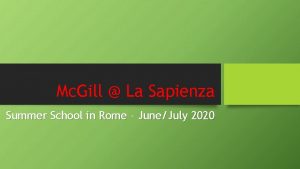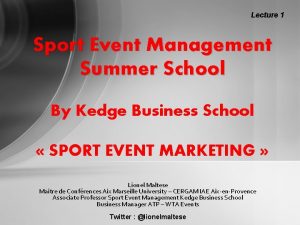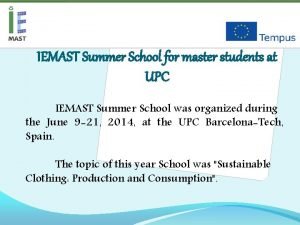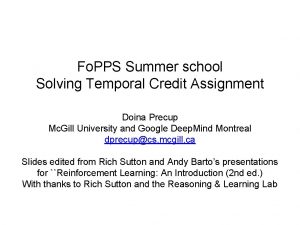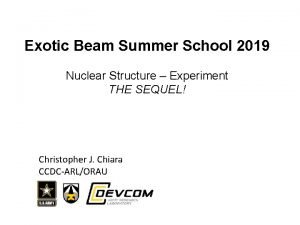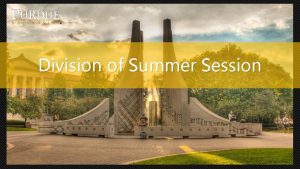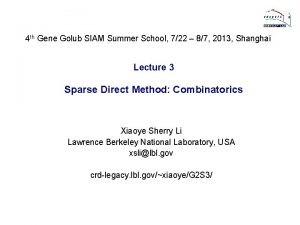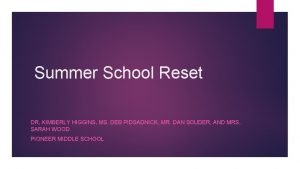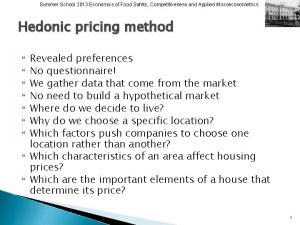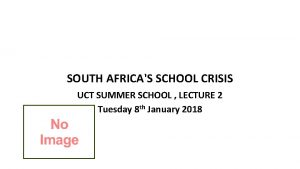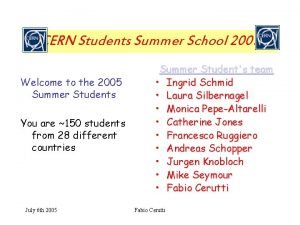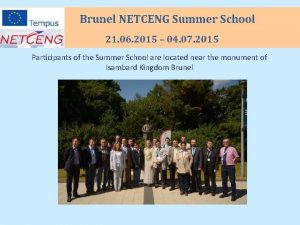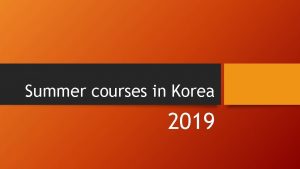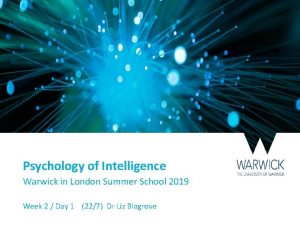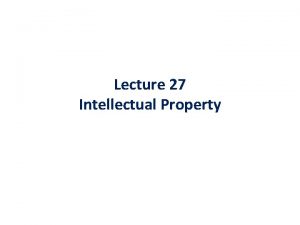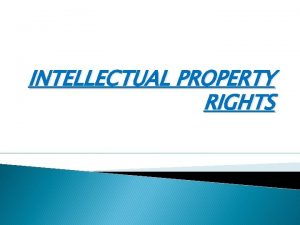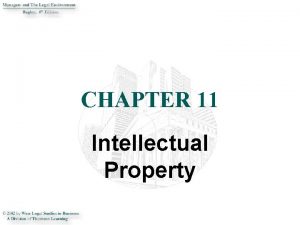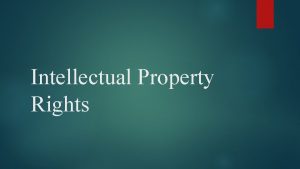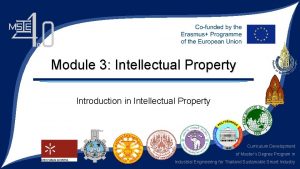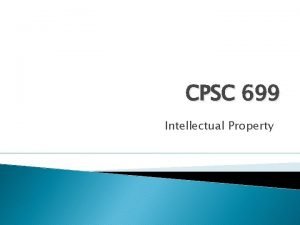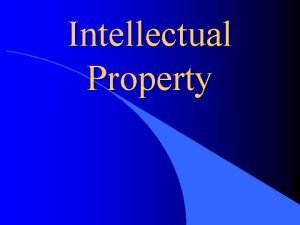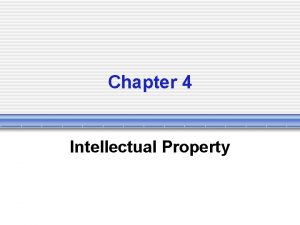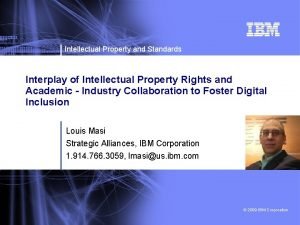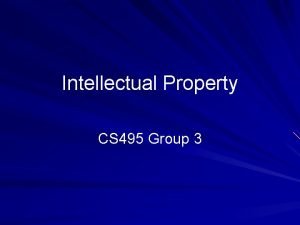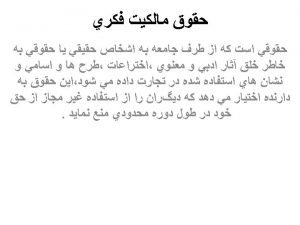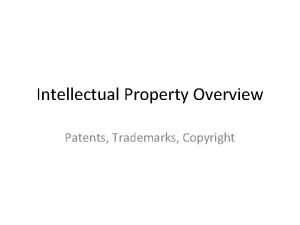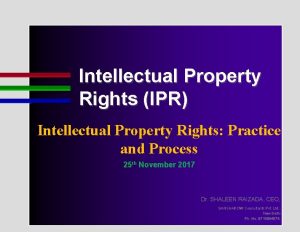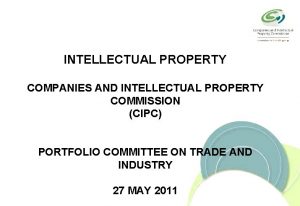WACQT SUMMER SCHOOL Introduction to Intellectual Property IP

















































- Slides: 49


WACQT SUMMER SCHOOL Introduction to Intellectual Property (IP) Peter Deakin and Victor Westergård August 2019

Agenda • • • Utilisation Why does Intellectual Property (IP) matter? Example of the use of different types of IP to protect a product Practical considerations IP in open networks Support available for WACQT • (Appendix: Types of IP and ownership, Patents / Knowhow, Copyright, Semiconductor topographies)

Utilisation is broader than commercialization

What is utilisation? ”What we do to ensure that our knowledge and results impact society and contribute to a sustainable future. ” 6/10/2021 Chalmers Innovationskontor 5

Utilisation? Everyone does it! We do it daily, perhaps without thinking about it

PRACTICES RULES & GOVERNANCE New products in use New services adopted New efficient processes implemented Changing organizational culture & practices Methods & Tools Thriving start-ups New or updated: Standards Laws & regulations Policies LOGICS & BELIEFS Change in: Perceptions Attitudes Beliefs Theories 17 SDG

Why does Intellectual Property (IP) matter?

Exclusive rights: Creation of an incentive to improve the world • IP Rights are legal rights for ‘creations of the mind’ • Grant exclusive control to decide who can e. g. make / sell a protected • • product / service Incentive designed to reward creativity / investment in bringing a product / service to the world Balance between inventor/owner and society – time limited exclusivity, then all of society can use the creation freely

What would happen to the creator’s motivation / incentive in the case that… • A pharma company brings a new cancer drug to market (cost of ~$2. 5 Bn and maybe 10 years work) • Clinical trials, manufacture & scale up, marketing & sales, distribution, etc. • But a competitor can launch a generic equivalent for a fraction of the cost?

Imperfect system, but it’s the best we’ve got • Criticisms of the patent system, for example, include: • • Different laws in different countries / territories Slowing / blocking innovation Poor patent quality – ‘granted too easily’ Patent Trolls – parasitic use of patents Litigation costs – risk to small companies vs. large Pharma industry – cost to developing countries Different industries but one system

* *manufacturing, technology and business services Source: Intellectual property rights intensive industries and economic performance in the European Union, Industry Level Analysis Report, October 2016, Second edition

Example of the use of different types of IP to protect a product

What product is this? US patent filed in 2005 Abstract: Disclosed herein is a multi functional hand held device capable of configuring user inputs based on how the device is to be used. Preferably, the multifunctional hand held device has at most only a few physical buttons, keys, or switches so that its display size can be substantially increased. Claim 2: A hand held electronic device as recited in claim 1, wherein said hand held electronic device includestwo or more of the following device functionalities: PDA, mobile phone, music player, camera, video player, game player, handtop, Internet terminal, GPS receiver, and remote control. WO 2006/094308 A 2

Apple i. Phone Source: https: //www. apple. com/iphone/

Examples of other types of IP protecting an i. Phone? Trademarks: Apple, i. Phone, Face. Time, i. Tunes, etc. Copyright: Software/Apps, i. OS Patents: control circuitry for LEDs, A system and method of locating “friends” devices on a network, methods of data processing, sensor for detecting force of touch on the screen, etc. Semiconductor chip topology: Apple A 12 Bionic (Apple designed system on a chip, includes implementation of 64 Bit ARM architecture)

Types of Intellectual property rights (IPR) • • Trademarks: protects ”designation of origin” (identity, reputation) Patents: protect what something is, how it works or what it can be used for (Utility models also exist, sometimes called ’patent light’) Designs: protects how something looks Copyright: protects original creative work (software, literature and art) Integrated Circuit Design: functional layout (topography) of an IC Know-how: may be confidential information as Trade secret Database rights: protect collections of data

Practical considerations (for academic researchers)

Practical considerations I: Creatorship / ownership General rule: a creator is someone who has made a creative, intellectual contribution to the IP (as defined by the relevant law) Consider: important experiments showing a method works vs. creating the method itself General rule: ownership follows creatorship, unless a contract / other law changes this Consider: employee of a Swedish company Consider: software created by an academic researcher in a collaboration with industry where a contract says the company owns the ‘arising IP’ Tip: Always check the contract!

Practical considerations II: Teacher´s exemption (Professor’s privilege) Found in two EU countries: Sweden + Italy Exemption like status also exists (Germany, Poland, Oxbridge…) Ownership of Intellectual Property created during course of employment lies with employer in many countries Often governed by employment agreement Swedish law contains two ’exemptions’ for teachers (Interpreted to include researchers) Rights to employee inventions: Lag (1949: 345) om rätten till arbetstagares uppfinningar Copyright to literary and artistic works, customary exemption: Lag (1960: 729) om upphovsrätt till litterära och konstnärliga verk Tip: Often changed by contract in collaborative projects with industry – always check the contracts!

Practical considerations III: Publication and IP IP is created all the time in research! Have you ever: thought: ‘that’s interesting…’, ‘that’s unexpected. . ’? written some software? designed something to be produced in a semiconductor? IP isn’t always needed: other forms of utilization There can be a tension between publication and capturing IP A patent application needs to be filed before publication! Tip: There may be (contractual) obligations to collaboration partners – always check the contract!

Tip: If in doubt contact your local Innovation Office https: //innovationskontor. chalmers. se/en https: //www. kth. se/en/innovation https: //www. innovation. lu. se/

Open networks – or ‘open’ networks

Open invention network - Linux Code contributed freely to the networks – can be used / modified by the network members BUT Applications / uses of the code are patent protected. Members agree to freely licence their patents to each other AND not to sue anyone CREATES a network that is both OPEN and CONTROLLED

Support for WACQT researchers

The Innovation Office offers free support… Identification of assets Collaboration with external partners Utilisation strategies Funding for verification – at an early stage Personal development Impact communication Help with applying for research funding Advice on patenting & licensing … suited to your needs and situation

Thanks for listening! Peter Deakin deakin@chalmers. se (Also available at MC 2 coffee every month) Victor Westergård wvictor@chalmers. se

Appendix

Types and ownership of Intellectual Property

Types of Intellectual property rights (IPR) • • Trademarks: protects ”designation of origin” (identity, reputation) Patents: protect what something is, how it works or what it can be used for (Utility models also exist, sometimes called ’patent light’) Designs: protects how something looks Copyright: protects expressions of ideas Integrated Circuit Design: functional layout (topography) of an IC Know-how: may be confidential information as Trade secret Database rights: protect collections of data

IPR protection periods • • • IC Design 10 years Patent 20 years Trademark renewed every 10 years, forever. . Copyright 70 years after death of author Design 5 x 5 years

Ownership of Intellectual Property • Main rule: inventor/creator etc. owns • Exceptions: • The employer • Work for hire • The ownership right may be assigned, as a whole or in part

Teacher´s exemption (Professor’s privilege) • Found in two EU countries: Sweden + Italy • • Ownership of Intellectual Property created during course of employment lies with employer in many countries, not in Sweden • • Often changed by employment agreement Swedish law contains two ’exemptions’ for teachers • • Exemption like status also exists (Germany, Poland, Oxbridge…) Interpreted to include researchers too Rights to employee inventions: Lag (1949: 345) om rätten till arbetstagares uppfinningar Copyright to literary and artistic works, customary exemption: Lag (1960: 729) om upphovsrätt till litterära och konstnärliga verk Often changed by contract in collaborative projects with industry

Patents

What is a patent? § Blunt economic instrument designed to incentivise innovation Owner: 20 year monopoly Society: Invention published Invention: More likely to be developed + basis for new inventions 6/10/2021 Chalmers Innovationskontor 35

What is a patent? • 20 years of exclusive right to prevent others from: • • Making Using Selling Importing • an invention disclosed in a granted patent, • in/to the country where the patent was granted (patent rights are • national) Enforceable in a court of law (Expensive to litigate…)

Patentability criteria • • Novelty – file before publication! Inventive step – surprising! Industrial applicability “Technical solution to a problem”

Examples of what can be patented within the electronics area Material per se (composition of matter) e. g. new (composition of) semiconductor material e. g. precursor material New use of material New combination of known materials (e. g. new device) Sources https: //www. olympus lifescience. com/es/microscope resource/primer/lightandcolor/ledsintro/ https: //www. sciencedirect. com/science/article/pii/S 2352507 X 15200091 US 2981877 Process of producing a material / device http: //www. edisontechcenter. org/semiconductors. htmlhttps: //chem. libretexts. org/@api/deki/files/97858/3. jp g? revision=1&size=bestfit&width=480&height=191 http: //iopscience. iop. org/article/10. 7567/JJAP. 54. 05 ED 05

Patent vs. Trade secret § Example of a trade secret protecting a product since 1891: § Ingredients: Carbonated Water, Sugar, Colour (Caramel E 150 d), Phosphoric Acid, Natural Flavourings Including Caffeine vs. 20 years negative right with recipe disclosed Utility of trade secrets in a world of open science? 2021 06 10 Chalmers Innovationskontor 39

Patent on ”computer/software implemented inventions” • EU/EPO Computer implemented invention (…that can be • patented): For a patent to be granted for a computer implemented invention, a technical problem has to be solved in a novel and non obvious manner. Software + interaction between hardware and industrial machine or process = TECHNICAL EFFECT

Software

”Software” Copyright - Ownership and commercial use Copyright is a legal right that arises automatically and grants the creator of an original work exclusive rights for its use and distribution. • Formalities? • No… but registration and © are useful • Copyright law: ownership- right to control use of software • Person creating (copyright in software belongs to researcher unless sponsorship states otherwise) • Employer under employment contract (though teacher’s exemption applies) • Commissioned work – transfer of ownership should be outlined in the agreement • The author / creator always has a moral right to be identified as such • Software copyright can be infringed: • Through literal copying: copy paste • Through non literal copying: same structures and the same steps, in the same order, to solve the same issue

Other means of protecting your ”software” More specific More conceptual PROTECTION FUNCTIONAL SYSTEMATIC SYMBOLIC OPERATIONAL DATA VALUE TO PROTECT Invention, implementation of an idea Design / Structure Works of authorship Source and Binary code Object Code Organisation or section of data MEANS OF PROTECTION Patents Trade Secrets Copyright, Licence Database rights RESTRICTS Use, Manufacture, Commercialise, Importing, … Disclosure Copying Distributing Modifying Decompiling, commercialisa tion, copying, etc. Access, extraction, reuse

How to protect data You (usually) cannot protect raw data (except by trade secrets) nor can you “license” data. A database is protected by copyright if the selection or arrangement of its content is original (EU Directive 96/9/EC). While the database as a whole can be protected by database rights. SO • You can legally protect and license the protected contents (Content license) • You can protect and license the access to the data/database (Access license) • You can legally protect and license the extraction and use of the organised data (Database license)

Licencing models • • Proprietary (closed) software Open source software • source = software in source code form • open = freedom to: • view the source code • to run the program for any purpose, • to study and modify the program, and • to freely redistribute copies of either the original or modified program (without royalties, etc. )

Software licencing

Integrated Circuit Designs

What is an IC Design? – An EU perspective • European Council Directive 87/54/EEC is the relevant EU framework: transposed into national law • Implementation varies across EU, some have registration schemes some treat as unregistered design rights • ~10 years of exclusive right to prevent others from: • • Reproducing a topography Commercially exploiting a topography Importing a topography or semiconductor product for commercial exploitation Research and teaching exemption provided for • If not exploited commercially or registered within 15 years, rights expire.

Criteria • Creator’s own intellectual effort • Not commonplace in the semiconductor industry • Combinations of commonplace topographies allowed • Registration needs to be done: • • • Either, within 15 years of first creation if not commercialized, or within 2 years of first commercial exploitation With exemplification of the topography With the date of first commercial exploitation stated (if applicable) • Costs: admin fee per country (e. g. NL € 79)
 Wacqt summer school
Wacqt summer school Trade related aspects of intellectual property rights
Trade related aspects of intellectual property rights Intellectual property rights in professional practices
Intellectual property rights in professional practices Importance of intellectual property
Importance of intellectual property Intellectual property management definition
Intellectual property management definition Licensing advantages
Licensing advantages Intellectual property business plan
Intellectual property business plan Intellectual property in computer ethics
Intellectual property in computer ethics Right to intellectual property of teachers
Right to intellectual property of teachers Definition of ipr
Definition of ipr Theories of intellectual property william fisher
Theories of intellectual property william fisher Concept of intellectual property
Concept of intellectual property Valuing intangible assets
Valuing intangible assets Intellectual property rights
Intellectual property rights Intellectual property rights
Intellectual property rights Characteristics of intellectual property
Characteristics of intellectual property Discuss intellectual property frankly
Discuss intellectual property frankly Gaap accounting for intellectual property
Gaap accounting for intellectual property Intellectual property
Intellectual property Intellectual property statement
Intellectual property statement Intellectual property business plan example
Intellectual property business plan example Evalueserve patent search
Evalueserve patent search Discuss intellectual property frankly
Discuss intellectual property frankly At&t intellectual property
At&t intellectual property Summer school lodi unified
Summer school lodi unified Crescenta valley high school graduation 2021
Crescenta valley high school graduation 2021 Assignment in spanish
Assignment in spanish Commutative property vs associative property
Commutative property vs associative property Obstructed heritage in hindu law
Obstructed heritage in hindu law Chemical property definition
Chemical property definition Annual rental value of the letout house is-
Annual rental value of the letout house is- Contractors method of valuation
Contractors method of valuation Ivc summer classes for high school students
Ivc summer classes for high school students Http://space-facts.com/the-moon/
Http://space-facts.com/the-moon/ Slam summer school
Slam summer school La sapienza summer school
La sapienza summer school Event management summer school
Event management summer school Summer school upc
Summer school upc Harvard study abroad summer
Harvard study abroad summer Pps summer school
Pps summer school Exotic beam summer school
Exotic beam summer school Purdue summer school
Purdue summer school Gene golub summer school
Gene golub summer school Dr kimberly higgins
Dr kimberly higgins Summer school 2013
Summer school 2013 Uct summer school
Uct summer school Cern summer school
Cern summer school кpi
кpi Snu summer school
Snu summer school Fluid intelligence example
Fluid intelligence example
